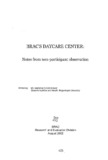BRAC's Daycare Center: notes from non-participant observation
Citation
Seeleman, M., & Straver, I. (2002, August). BRAC’s Daycare Center: notes from non-participant observation. Research Reports (2002): Social Studies, Vol – XXX, 425–443.Abstract
This non-participant observation study on BRAC's day care centre for the toddlers (started in 1997, located
near the BRAC head office and run by GRC of BRAC) was done to see the existing condition of the center
and how effectively it conforms to the early childhood development principles. Based on the daily
schedule, four different points in time during four subsequent days we;e chosen for one-hour observations
by two observers with the different ECD-aspects of the observation scheme in mind. To ensure objectivity,
the observers tried to interact as little as possible with the children and the attendants. It was observed that
the daycare center is a large place (100 m2
) consisting off our different spaces for sleep, breast-feeding,
play etc. The place appears very clean. It is cleaned twice a day by a cleaner and the attendants clean it as
and when required. The place looks also safe. The children were allowed to move around freely and
explore. Attendants only interfered when the exploring was harmful or seemed dangerous. Not many toys
were available, except for some plastic squeeze-animals. Babies were supported to sit and stand if they
could, but this was not frequent. Other physical development stimulation was noticed when an attendant
showed a child how to draw a figure, or when an attendant was clapping her hands and a baby tried to
imitate her and also when an attendant sang a song and meanwhile moved the legs of a baby. The
possibilities for children to learn by touching, tasting, hearing, seeing and moving were quite limited. A lot
of communication between children and attendants took place in spite of their age. The children were not
taught concepts of colors, number or symmetry and their creativity was not intentionally challenged.
Nevertheless, attendants demonstrated certain things to children, such as pointing out body parts or drawing
little circles on a piece of paper. The children were taught some appropriate behavior, for instance to say
goodbye to the observers or to share candy, to put things away or to show praise to another child who
achieved something. They also got corrected in a friendly and verbal way while misbehaving. In the
interaction between attendants and children, gender differences have not been observed. Most of the
children seemed happy and quite at ease in the daycare center. Attendants were very patient with the
children during feeding, especially when they had difficulties with eating. The possibilities for play were
not very elaborate and playing was also not very much stimulated. No joint activities, like singing together
or story telling, where most of the children can take part in, take place. Given the limitations, it is
concluded that the daycare center's environment is stimulating for these children and gives them a head
start compared to a child of the same age who stays at home and is looked after by a family member or
servant. The implications of these findings and suggestions for improvement are discussed.

